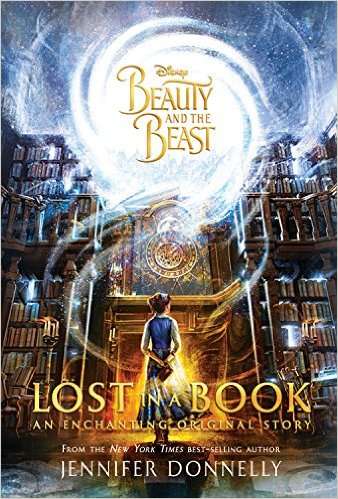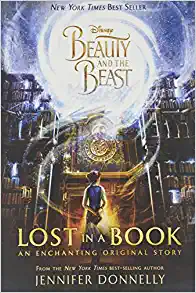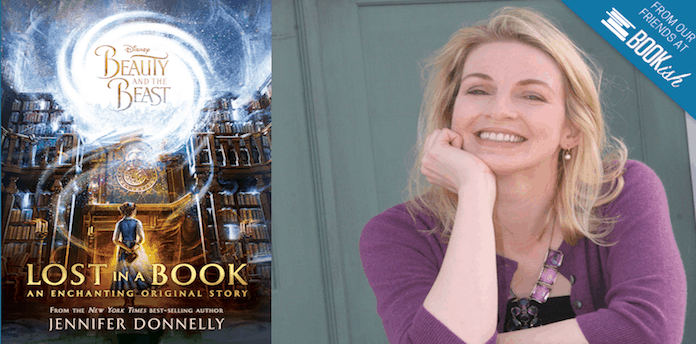Beauty and the Beast: Lost in a Book by Jennifer Donnelly
BookTrib is partnering with Bookish to bring you more great content, including this Q&A with Jennifer Donnelly about Beauty and the Beast: Lost in a Book!
New York Times bestselling author Jennifer Donnelly sat down with Bookish to discuss her latest release, the No. 1 teen and YA Amazon bestseller, Beauty and the Beast: Lost in a Book. Below she discusses how she worked with Disney to make this enchanting tale come together!
Belle craves adventure in the great wide somewhere, but she gets more than she bargained for when she opens a mysterious book in the Beast’s library and is transported to a world created by Death herself. Jennifer Donnelly’s middle grade novel, Beauty and the Beast: Lost in a Book, follows Belle in her early days in the enchanted castle. Here, Donnelly shares the challenges of capturing such iconic characters and developing them for a new story.
Dying to read this new take on a classic tale? Check out Bookish’s Belle’s Library giveaway.
Bookish: You were given a sneak peek at the script for the 2017 movie, Beauty and the Beast. Were there any other guidelines you had from Disney for the plot or characterizations?
 Jennifer Donnelly: I did get the script! And it was a delight to read—deft, charming, funny, and moving. It had a combination of sweetness and groundedness that I found very appealing.
Jennifer Donnelly: I did get the script! And it was a delight to read—deft, charming, funny, and moving. It had a combination of sweetness and groundedness that I found very appealing.
The main guideline from Disney was that my story had to fit within the script’s timeline. So I was thinking: What other adventures did Belle have that we don’t know about? I had to find a dusty, untraveled corridor in the enchanted castle, so to speak, for her to explore, but make sure it didn’t stop the forward action of the major events we all know and expect.
Bookish: As Belle discovers, a truly fulfilling life isn’t one devoid of struggles. In your own journey of writing this book, what was the most challenging aspect of tackling such an iconic tale?
JD: The deadline! Because of scheduling constraints, I had four months to write Lost in a Book. I had never, ever attempted anything that crazy before. My other novels had all taken me a lot longer to write. But I took the challenge on and I learned something hugely important that I want to share with aspiring writers: Whether a first draft takes four months to write, or four years… it’s going to stink. That is a fact. So just get on with it. Jump in and make that big fat messy first draft. Take a breath, and then start your second draft. Your third. Your fourth. Because that mess? That is writing—making the mess less messy until it’s no longer a mess.
Bookish: Some of the scenes in the book reflect the animated Disney classic (such as Beast giving Belle the library), while others are from the original fairytale (the father picking a rose from the Beast’s garden). How did you decide which elements to include?
JD: This is a very rational question, and I wish I could give a rational answer, but I can’t because the process of making a story isn’t terribly rational. The story dictates what it wants and what it doesn’t, and the author’s job is to listen, and to feel her way, and basically to be a servant of that story.
Bookish: Belle’s relationship with the Beast is one of friendship, rather than true love. Why did you decide to take that direction?
JD: I’m really interested in Belle’s early days in the castle, when Belle is discovering who the Beast really is, and he’s discovering who she really is. I like how they take each other’s measure. I think true friendship—an honest appraisal and appreciation of another human being—is the genuine basis for true love, and I really like how Belle and the Beast’s relationship progresses from friendship to love.
Bookish: You write about Love and Death as sisters. Why did you choose to give them that bond, and what do you think it represents about their relationship?
JD: I see Love and Death as true relations, and true adversaries. We can’t escape Death, but we can defeat her by loving each other. And I’m not talking only about romantic love. I’m talking about the love between parents and children. That love makes Belle the strong person she is. The lack of that love damages Beast—almost irreparably. I’m also talking about the love between friends. Death nearly scores an early victory in Lost in a Book when Belle succumbs to the ease of false, pretty, glittery friendships and forgets to engage in the hard, messy work of making true friends.
Bookish: Belle realizes how easy it is to lose yourself in something you love and forget the world around you. Her passion is nearly her downfall. Why did you decide to tie her love of books to the danger she faces? Is there a message there for readers about not neglecting the outside world?
JD: I think it’s important for all of us, myself included, not to let an escape become escapism. I recently saw a documentary in which a teen girl spent almost all her free time on social media churning out fan posts. It seemed like her whole life was defined by the achievements of others, which made me really sad. I wanted to make the point, especially to younger readers, that it’s wonderful to read stories (or posts, or tweets) that others have written, but don’t neglect to write your own story. Define yourself. Don’t let anyone else do it for you.
Bookish: If you could step into a book, which one would you choose?
Jennifer Donnelly: You can’t possibly be serious about limiting me to one book. You just can’t. So here goes: Every single one of Grimm’s Fairy Tales. My whole life, I’ve wanted to take a bite out of the gingerbread house, see a pumpkin turn into a carriage, and watch the evil queen flip out as the mirror tells her she’s not the fairest. Where the Wild Things Are, to join the wild rumpus! The Lion, the Witch and the Wardrobe, to hang with Aslan and see what Jadis is wearing. The Golden Compass, to see what my own daemon looks like. The Shining, because I’m insane. And pretty much every history book I’ve ever read so I can step into the court of Elizabeth Tudor, watch the sans-culottes storm the Bastille, and listen to Mozart play live.
Bookish: We already know that every reader wants the giant library. But is there anything else in Beast’s castle you’d like to possess?
JD: Ha! Where do I start? Cuisiniere, so I never have to cook again. That would make me very happy, and my family even happier. Madame de Garderobe, so I could have a gorgeous new outfit every day of my life. And the castle itself! It’s spooky and gorgeous—my favorite combo!
Bookish: If you were able to write a book in the world of any other Disney character, which would you choose?
JD: Cinderella’s fairy godmother might be fun to write about. What does she get up to when she isn’t turning mice into horses, and raggedy dresses into ballgowns? What does she eat? Who are her friends? What does her house look like? Hmmm…
Bookish: What is it about fairy tales that you think continues to resonate with modern readers?
JD: Fairy tales were therapy before Freud invented it. Though grounded in their time, fairy tales still matter in ours because they give voice to our deepest fears, and by doing so, they help us resolve them. They tell us there are monsters, but they also tell us how to beat them. We humans need that—no matter how modern we may think we are.
Buy this Book!
Amazon





